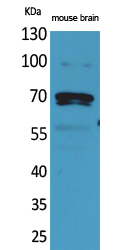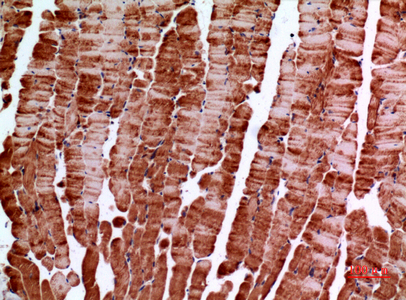Amphiphysin II Polyclonal Antibody
- Catalog No.:YT5316
- Applications:WB;IHC;IF;ELISA
- Reactivity:Mouse;Rat
- Target:
- Amphiphysin II
- Fields:
- >>Endocytosis;>>Fc gamma R-mediated phagocytosis
- Gene Name:
- BIN1
- Protein Name:
- Myc box-dependent-interacting protein 1
- Human Gene Id:
- 274
- Human Swiss Prot No:
- O00499
- Mouse Gene Id:
- 30948
- Mouse Swiss Prot No:
- O08539
- Rat Gene Id:
- 117028
- Rat Swiss Prot No:
- O08839
- Immunogen:
- Synthesized peptide derived from the C-terminal region of human Amphiphysin II.
- Specificity:
- Amphiphysin II Polyclonal Antibody detects endogenous levels of Amphiphysin II protein.
- Formulation:
- Liquid in PBS containing 50% glycerol, 0.5% BSA and 0.02% sodium azide.
- Source:
- Polyclonal, Rabbit,IgG
- Dilution:
- WB 1:500 - 1:2000. IHC: 1:100-1:300. ELISA: 1:20000.. IF 1:50-200
- Purification:
- The antibody was affinity-purified from rabbit antiserum by affinity-chromatography using epitope-specific immunogen.
- Concentration:
- 1 mg/ml
- Storage Stability:
- -15°C to -25°C/1 year(Do not lower than -25°C)
- Other Name:
- BIN1;AMPHL;Myc box-dependent-interacting protein 1;Amphiphysin II;Amphiphysin-like protein;Box-dependent myc-interacting protein 1;Bridging integrator 1
- Observed Band(KD):
- 64kD
- Background:
- This gene encodes several isoforms of a nucleocytoplasmic adaptor protein, one of which was initially identified as a MYC-interacting protein with features of a tumor suppressor. Isoforms that are expressed in the central nervous system may be involved in synaptic vesicle endocytosis and may interact with dynamin, synaptojanin, endophilin, and clathrin. Isoforms that are expressed in muscle and ubiquitously expressed isoforms localize to the cytoplasm and nucleus and activate a caspase-independent apoptotic process. Studies in mouse suggest that this gene plays an important role in cardiac muscle development. Alternate splicing of the gene results in several transcript variants encoding different isoforms. Aberrant splice variants expressed in tumor cell lines have also been described. [provided by RefSeq, Mar 2016],
- Function:
- alternative products:Additional isoforms seem to exist,disease:Defects in BIN1 are the cause of centronuclear myopathy autosomal recessive (ARCNM) [MIM:255200]; also known as autosomal recessive myotubular myopathy. Centronuclear myopathies are congenital muscle disorders characterized by progressive muscular weakness and wasting involving mainly limb girdle, trunk, and neck muscles. It may also affect distal muscles. Weakness may be present during childhood or adolescence or may not become evident until the third decade of life. Ptosis is a frequent clinical feature. The most prominent histopathologic features include high frequency of centrally located nuclei in muscle fibers not secondary to regeneration, radial arrangement of sarcoplasmic strands around the central nuclei, and predominance and hypotrophy of type 1 fibers.,function:May be involved in regulation of synaptic vesicle end
- Subcellular Location:
- [Isoform BIN1]: Nucleus . Cytoplasm . Endosome . Cell membrane, sarcolemma, T-tubule .; [Isoform IIA]: Cytoplasm .
- Expression:
- Ubiquitous. Highest expression in the brain and muscle (PubMed:9182667). Expressed in oligodendrocytes (PubMed:27488240). Isoform IIA is expressed only in the brain, where it is detected in the gray matter, but not in the white matter (PubMed:27488240). Isoform BIN1 is widely expressed with highest expression in skeletal muscle.
PTENα regulates endocytosis and modulates olfactory function. FASEB JOURNAL 2019 Jul 10 WB Human,Mouse 1:1000 olfactory bulb (OB) HEK293T cell
- June 19-2018
- WESTERN IMMUNOBLOTTING PROTOCOL
- June 19-2018
- IMMUNOHISTOCHEMISTRY-PARAFFIN PROTOCOL
- June 19-2018
- IMMUNOFLUORESCENCE PROTOCOL
- September 08-2020
- FLOW-CYTOMEYRT-PROTOCOL
- May 20-2022
- Cell-Based ELISA│解您多样本WB检测之困扰
- July 13-2018
- CELL-BASED-ELISA-PROTOCOL-FOR-ACETYL-PROTEIN
- July 13-2018
- CELL-BASED-ELISA-PROTOCOL-FOR-PHOSPHO-PROTEIN
- July 13-2018
- Antibody-FAQs
- Products Images

- Western Blot analysis of mouse brain cells using Amphiphysin II Polyclonal Antibody. Secondary antibody(catalog#:RS0002) was diluted at 1:20000
.jpg)
- Immunohistochemical analysis of paraffin-embedded human-pancreas, antibody was diluted at 1:100

- Immunohistochemical analysis of paraffin-embedded mouse-muscle, antibody was diluted at 1:100



